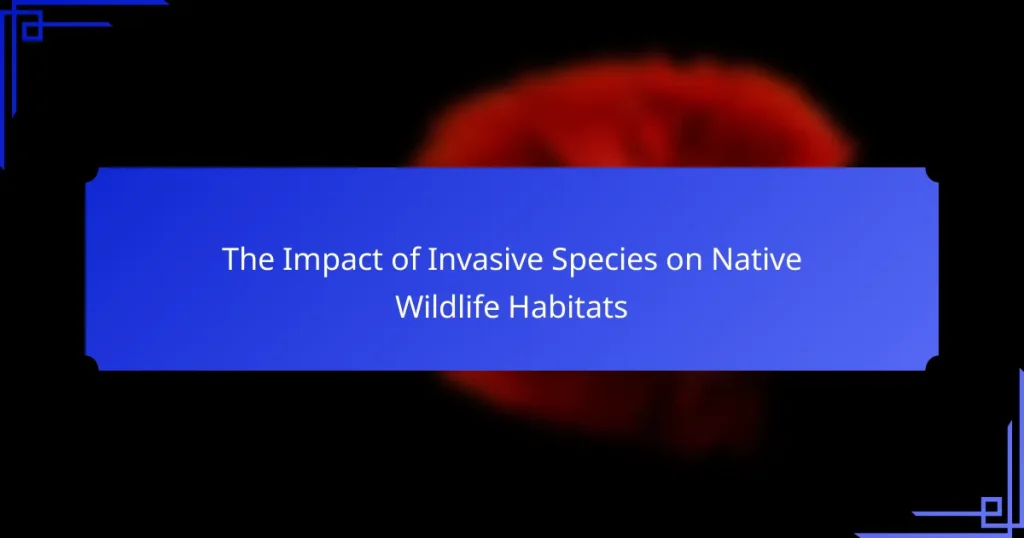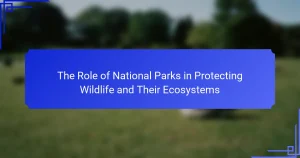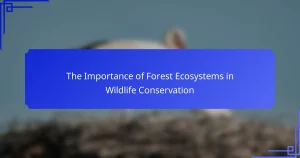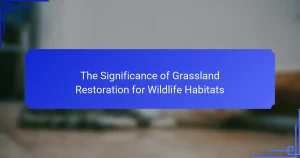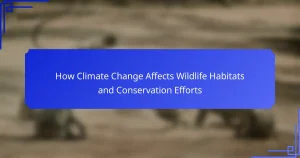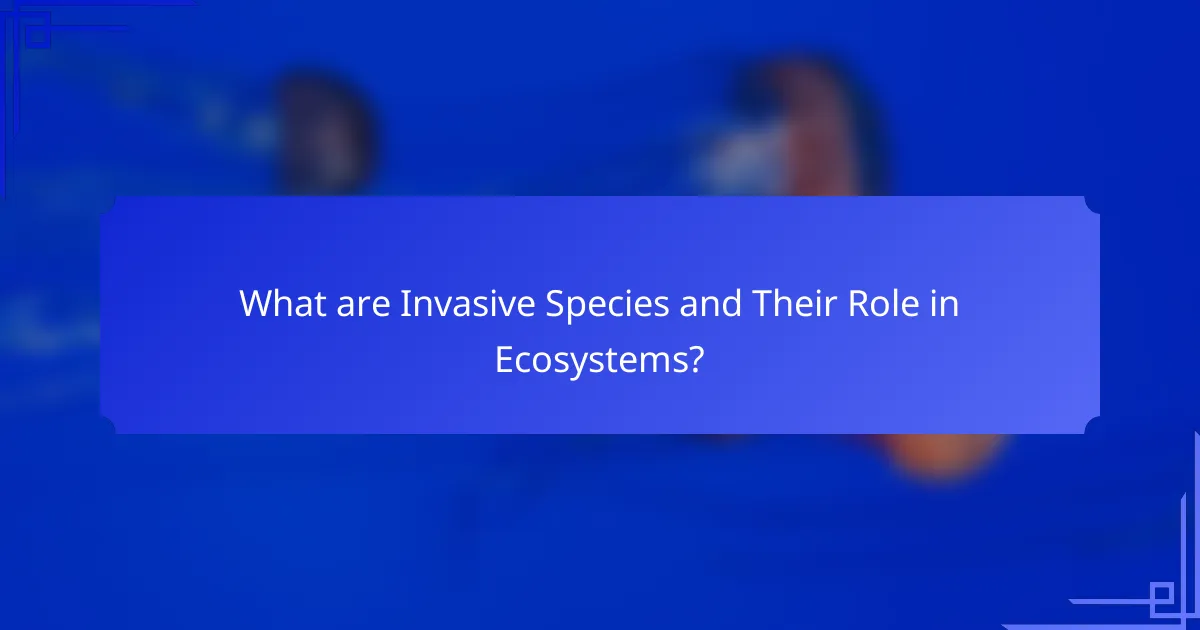
What are Invasive Species and Their Role in Ecosystems?
Invasive species are non-native organisms that disrupt local ecosystems. They often outcompete native species for resources. This can lead to declines in native populations. Invasive species can alter habitat structure and nutrient cycling. They may introduce diseases that affect native wildlife. The introduction of invasive species often results from human activities. Examples include the zebra mussel in North America. This species has caused significant ecological and economic damage. Invasive species can reduce biodiversity and change community dynamics. Their role in ecosystems is primarily negative, impacting native wildlife habitats.
How do invasive species differ from native species?
Invasive species differ from native species primarily in their origin and ecological impact. Native species are those that naturally occur in a specific region and have adapted to local environmental conditions. In contrast, invasive species are introduced organisms that thrive outside their native habitat, often due to human activity.
Invasive species can outcompete native species for resources such as food and habitat. This competition can lead to declines in native populations and disrupt local ecosystems. For example, the zebra mussel, an invasive species in North America, has drastically altered aquatic ecosystems by filtering out nutrients needed by native species.
Furthermore, invasive species can introduce diseases that native species are not equipped to handle. The brown tree snake, introduced to Guam, has led to the extinction of several native bird species through predation. In summary, the key differences lie in origin, ecological roles, and the potential for negative impacts on native species and ecosystems.
What characteristics define an invasive species?
Invasive species are organisms that are not native to a specific ecosystem and cause harm. They typically have rapid reproduction rates, allowing them to spread quickly. These species often outcompete native species for resources such as food and habitat. Invasive species can disrupt local ecosystems and alter habitat structures. They may introduce diseases that native species are not equipped to handle. Their presence can lead to declines in biodiversity and changes in food webs. According to the U.S. Fish and Wildlife Service, invasive species are a leading cause of extinction for native wildlife.
Why are some species considered invasive in specific regions?
Some species are considered invasive in specific regions due to their ability to outcompete native species for resources. Invasive species often lack natural predators in their new environments. This allows them to proliferate rapidly. They can disrupt local ecosystems by altering habitat structures. Invasive species may also introduce diseases that native species cannot withstand. For example, the zebra mussel has significantly impacted aquatic ecosystems in North America. It competes with native mussels for food and space, leading to declines in native populations. Such dynamics illustrate why certain species are labeled invasive in particular regions.
What are the general impacts of invasive species on ecosystems?
Invasive species significantly disrupt ecosystems. They often outcompete native species for resources. This competition can lead to declines or extinctions of native populations. Invasive species may alter habitat structure and function. For example, they can change nutrient cycling and water availability. These changes can affect the entire food web. Invasive species can introduce diseases to which native species have no immunity. According to the U.S. Fish and Wildlife Service, invasive species are a leading cause of biodiversity loss. Their impacts can lead to long-term ecological imbalances.
How do invasive species affect biodiversity?
Invasive species negatively affect biodiversity by outcompeting native species for resources. They often disrupt local ecosystems and alter habitat structures. For instance, invasive plants can dominate landscapes, reducing the diversity of native flora. This can lead to declines in native animal populations that rely on those plants for food and shelter. Additionally, invasive species can introduce diseases that native species are not adapted to withstand. According to the U.S. Fish and Wildlife Service, invasive species are a leading cause of extinction for native wildlife. The introduction of invasive predators can also threaten native prey species, further diminishing biodiversity.
What are the ecological consequences of invasive species?
Invasive species disrupt ecosystems and cause significant ecological consequences. They often outcompete native species for resources, leading to declines or extinctions. Invasive plants can alter soil chemistry and nutrient cycling. This change impacts native plant communities and the animals that depend on them. Predatory invasive species can reduce populations of native prey species. This shift can lead to imbalances in food webs. Invasive species can also introduce diseases that native species have no resistance against. These ecological disruptions can ultimately reduce biodiversity and ecosystem resilience.

How do Invasive Species Specifically Impact Native Wildlife Habitats?
Invasive species disrupt native wildlife habitats by outcompeting native species for resources. They often reproduce rapidly and can dominate ecosystems. For example, the zebra mussel outcompetes native mussels for food and space in North American waters. Invasive plants can choke out native vegetation, altering habitats. This can lead to decreased biodiversity and the loss of native species. The introduction of predators like the brown tree snake has caused declines in native bird populations in Guam. Invasive species can also introduce diseases to which native wildlife has no immunity. Overall, these impacts can destabilize ecosystems and reduce their resilience.
What are the mechanisms through which invasive species affect native wildlife?
Invasive species affect native wildlife through competition, predation, and disease transmission. Competition occurs when invasive species utilize resources that native species depend on. This can lead to declines in native populations as they struggle to access food, habitat, or other essential resources. Predation by invasive species can drastically reduce native wildlife numbers. For example, invasive predators may outcompete or prey on native species that lack defenses against them. Disease transmission is another mechanism, as invasive species can introduce pathogens to which native wildlife have no immunity. This can lead to significant declines in native populations and disrupt local ecosystems. These mechanisms collectively threaten biodiversity and alter ecosystem dynamics, impacting the overall health of habitats.
How do invasive species compete with native species for resources?
Invasive species compete with native species for resources by outcompeting them for food, space, and other necessities. They often have faster growth rates and reproductive cycles, allowing them to dominate quickly. Invasive plants can overshadow native plants, limiting their access to sunlight. Invasive animals may prey on native species or consume their food sources. This competition can lead to declines in native populations and biodiversity. Studies show that invasive species can cause significant shifts in ecosystem dynamics. For example, the introduction of the zebra mussel in North America has led to declines in native mussel populations. This highlights the substantial impact invasive species have on native wildlife habitats.
What role do invasive species play in altering habitat structures?
Invasive species significantly alter habitat structures. They can outcompete native species for resources, leading to changes in plant community composition. This alteration affects the availability of food and shelter for native wildlife. Invasive plants may also change soil chemistry and nutrient cycling. For example, species like Japanese knotweed can disrupt riverbank stability. This results in increased erosion and altered water flow patterns. Research shows that invasive species can reduce biodiversity by displacing native flora and fauna. Consequently, these changes can lead to a decline in ecosystem resilience and function.
How do invasive species disrupt food webs in native habitats?
Invasive species disrupt food webs in native habitats by outcompeting native species for resources. They often have no natural predators in the new environment, allowing their populations to grow unchecked. This leads to the decline or extinction of native species that share similar ecological niches. For example, invasive plants can dominate landscapes, reducing the availability of light and nutrients for native flora. Invasive predators can significantly reduce populations of native prey species, impacting the entire food chain. Research indicates that invasive species are a leading cause of biodiversity loss globally. According to the Global Invasive Species Database, they threaten over 1,000 native species in various ecosystems.
What specific examples illustrate the disruption of food chains?
Invasive species such as the zebra mussel disrupt food chains by outcompeting native species for resources. They filter large amounts of water, removing phytoplankton that serves as food for native fish. The introduction of the brown tree snake in Guam has led to the decline of native bird populations, disrupting predator-prey dynamics. Another example is the emerald ash borer, which decimates ash trees, affecting species that rely on these trees for habitat and food. The introduction of lionfish in the Caribbean has resulted in the decline of native fish populations, altering the ecosystem balance. These examples illustrate how invasive species can significantly disrupt established food chains and ecosystems.
How do invasive species influence predator-prey relationships?
Invasive species significantly alter predator-prey relationships in ecosystems. They can outcompete native species for resources, reducing the availability of prey for native predators. Invasive predators may also directly prey on native species, leading to population declines. For example, the introduction of the brown tree snake in Guam has caused the extinction of several bird species. Additionally, invasive species can disrupt food webs by introducing new diseases or parasites. This dynamic can lead to an imbalance in the ecosystem, affecting biodiversity. Studies show that ecosystems with invasive species often experience reduced resilience to environmental changes.
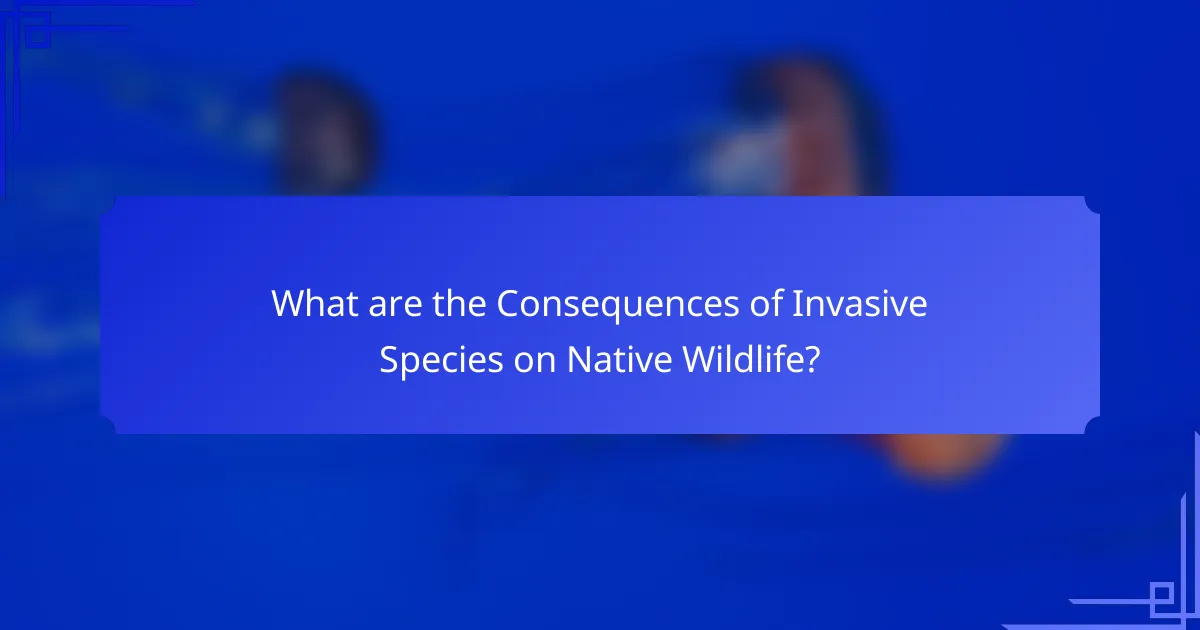
What are the Consequences of Invasive Species on Native Wildlife?
Invasive species negatively impact native wildlife by disrupting ecosystems. They compete for resources such as food and habitat. This competition often leads to a decline in native species populations. Invasive species can introduce diseases that native wildlife is not equipped to handle. Predation by invasive species can result in the extinction of vulnerable native species. For example, the brown tree snake has caused significant declines in native bird populations in Guam. Invasive plants can alter habitats, making them unsuitable for native wildlife. Overall, the presence of invasive species can lead to decreased biodiversity and ecosystem health.
What are the direct effects of invasive species on native wildlife populations?
Invasive species directly affect native wildlife populations through competition, predation, and habitat alteration. They compete for resources such as food and shelter, often outcompeting native species. This competition can lead to a decline in native populations. Additionally, invasive species can introduce new predators that threaten native wildlife. For example, the introduction of brown tree snakes in Guam has led to the extinction of several bird species. Invasive plants can alter habitats, making them unsuitable for native species. These changes disrupt food webs and ecological balance. Overall, invasive species pose a significant threat to biodiversity and ecosystem stability.
How do invasive species contribute to the decline of native species?
Invasive species contribute to the decline of native species primarily by outcompeting them for resources. They often reproduce rapidly and can dominate habitats. This competition leads to reduced food, space, and other essential resources for native species. Invasive species can also introduce diseases that native species have no immunity against. For example, the introduction of the chytrid fungus has devastated amphibian populations worldwide. Additionally, invasive predators can directly prey on native species, further reducing their populations. The overall impact is a significant loss of biodiversity and disruption of local ecosystems.
What are the long-term consequences for native wildlife habitats?
Invasive species can lead to severe long-term consequences for native wildlife habitats. They disrupt local ecosystems by outcompeting native species for resources. This competition can result in the decline or extinction of native species. Additionally, invasive species can alter habitat structures, making them less suitable for native wildlife. For example, invasive plants may change soil chemistry and water availability. These changes can affect the entire food web, from plants to herbivores to predators. Long-term consequences also include reduced biodiversity and ecosystem resilience. Studies show that ecosystems with high levels of invasive species have lower overall health and functionality.
How do invasive species impact the reproductive success of native wildlife?
Invasive species negatively impact the reproductive success of native wildlife. They compete for resources such as food and nesting sites. This competition can lead to reduced availability of essential resources for native species. Invasive predators may also directly prey on native species, further decreasing their populations. For example, the introduction of brown tree snakes in Guam has led to the decline of several bird species. Additionally, invasive plants can alter habitats, making them unsuitable for native wildlife. These changes can disrupt breeding behaviors and reduce reproductive rates. Studies show that native species often struggle to adapt to the pressures imposed by invasive species.
What are the observed changes in breeding patterns due to invasive species?
Invasive species cause significant changes in the breeding patterns of native wildlife. These species often outcompete native organisms for resources, leading to reduced reproductive success. For example, invasive plants can alter habitat structure, affecting nesting sites for birds. Predation by invasive species can also increase, reducing the survival rates of native offspring. Additionally, hybridization occurs when invasive species interbreed with natives, leading to genetic dilution. Studies have shown that these changes can lead to population declines in affected species. For instance, the introduction of the brown tree snake in Guam severely impacted native bird populations by preying on eggs and young. Overall, invasive species disrupt the natural breeding behaviors and cycles of native wildlife.
How do invasive species affect the survival rates of young native wildlife?
Invasive species significantly reduce the survival rates of young native wildlife. They compete for resources such as food and habitat. This competition can lead to malnutrition and decreased growth rates in young animals. Invasive predators may also directly threaten young native wildlife. For instance, they can increase predation rates on vulnerable species. Additionally, invasive plants can alter habitats, making them less suitable for native wildlife. Research indicates that areas with high invasive species presence have lower populations of young native animals. This trend emphasizes the detrimental impact of invasives on ecosystem balance and biodiversity.
What strategies can be employed to mitigate the impact of invasive species on native wildlife habitats?
Control and management strategies can mitigate the impact of invasive species on native wildlife habitats. These strategies include early detection and rapid response to invasions. Implementing physical removal methods, such as hand-pulling or mechanical harvesting, can effectively reduce invasive populations. Using chemical controls, like herbicides or pesticides, can also help manage invasive species when applied correctly.
Restoration of native habitats is crucial. This can involve replanting native vegetation to outcompete invasive species. Public education and community involvement enhance awareness and support for invasive species management. Monitoring and research are essential for evaluating the effectiveness of these strategies.
According to the National Invasive Species Council, these methods have proven successful in various ecosystems across the United States.
What best practices are recommended for managing invasive species?
Best practices for managing invasive species include prevention, early detection, and rapid response. Prevention involves measures to avoid the introduction of invasive species to new areas. This can include regulations on the transport of plants and animals. Early detection means monitoring ecosystems for signs of invasive species presence. Rapid response entails implementing control measures quickly after detection. Control methods can include mechanical removal, chemical treatments, and biological control. Collaboration among stakeholders is essential for effective management. Education and outreach help raise awareness about invasive species impacts. These practices are supported by studies showing that proactive management reduces the spread of invasives and protects native habitats.
How can conservation efforts support native wildlife resilience against invasives?
Conservation efforts can enhance native wildlife resilience against invasive species through habitat restoration and management. These efforts create healthier ecosystems that support native species. By removing invasive plants and animals, conservation initiatives reduce competition for resources. This allows native species to thrive and maintain their populations.
Additionally, conservation programs can promote biodiversity. Increased biodiversity strengthens ecosystem stability and resilience. For instance, diverse habitats can better withstand invasions due to the presence of various native species.
Research shows that targeted conservation actions, such as controlled burns and reforestation, can effectively limit invasive species spread. A study in the Journal of Applied Ecology found that habitat restoration significantly improved native bird populations in areas previously dominated by invasives.
Overall, effective conservation strategies directly contribute to the resilience of native wildlife against invasive threats.
The main entity of this article is invasive species and their impact on native wildlife habitats. Invasive species are non-native organisms that disrupt local ecosystems by outcompeting native species for resources, altering habitat structures, and introducing diseases. The article discusses how these species negatively affect biodiversity, food webs, and predator-prey relationships, leading to declines in native populations and ecosystem health. It also highlights various strategies for mitigating the impact of invasive species, including habitat restoration and management practices aimed at enhancing the resilience of native wildlife.
